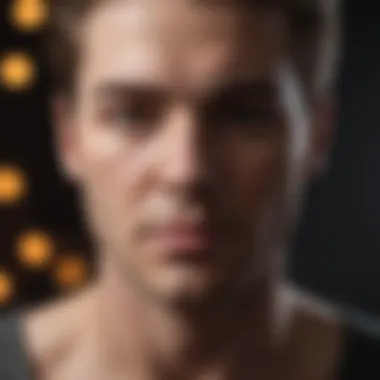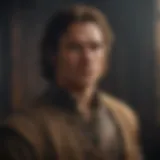Power Book Two: A Comprehensive Analysis of the Series


Intro
"Power Book Two: Ghost" takes us deeper into the perilous world birthed by its predecessor, "Power." With this spinoff, fans get more than just a continuation; they get a rich tapestry woven with complex characters and intense situations. The series builds on the legacy of the original and navigates the murky waters of family loyalty, ambition, and the relentless pursuit of power.
In this exploration, we will dissect its multifaceted narrative, character growth, and how the show mirrors societal themes that resonate today. With a keen eye on critical and audience responses, we aim to place "Power Book Two" in the larger landscape of modern television storytelling.
Overview of the Entertainment, TV Show, or Film discussed
"Power Book Two: Ghost" serves as a gateway back into the intricate universe of "Power." This compelling narrative picks up shortly after the cataclysmic events of the original series, thrusting viewers straight into the life of Tariq St. Patrick.
Background information about the entertainment piece or production being reviewed
Created by Courtney A. Kemp, who also helmed the original, this series expands the “Power” universe while delving into themes of identity, morality, and the ever-blurring lines between right and wrong. With Tariq now navigating his new life as a college student, the stakes are higher than ever as he must reconcile his father's legacy with his own ambitions.
Brief synopsis of the plot or storyline
In the wake of James St. Patrick's death, Tariq finds himself entangled in a web of secrets, lies, and precarious alliances. As he strives to balance school while reconnecting with his family, he also grapples with the criminal empire that his father once controlled. Alongside a cast of characters who have their own hidden motives, the series unveils layers upon layers of conflict and drama that build to an unforgettable crescendo.
Key details about the creators, directors, actors, or showrunners
Courtney A. Kemp has consistently demonstrated her prowess in crafting intricate narratives. She collaborates with executive producer 50 Cent (Curtis Jackson), whose influence adds another layer of authenticity to the storytelling. The cast includes Michael Rainey Jr. as Tariq, who carries the weight of the series on his young shoulders. He is joined by seasoned actors such as Mary J. Blige and Method Man, whose performances breathe life into the tumultuous world of "Power."
Analysis and Critique
The execution of "Power Book Two" provides a compelling critique of the consequences tied to ambition and familial obligations. Each episode is a meticulously crafted piece that expertly ties together action and character development.
Evaluation of the performance, direction, writing, cinematography, or other such aspects
The performances are particularly noteworthy. Michael Rainey Jr. balances Tariq's vulnerabilities with his resolve, showcasing a young man in conflict. The direction maintains a consistency that keeps the tension palpable. The writing subtly draws parallels between Tariq’s journey and the societal pressures that young adults face today, making it relevant to a broad audience.
Comparison to similar works or previous seasons/episodes
When viewed alongside the original series, this spinoff does well in capitalizing on established relationships while also introducing new dynamics, enriching the storyline. The gritty realism remains intact, yet the series cleverly shifts slow-burn story arcs into more immediate conflicts, elevating the stakes in each episode.
Identification of themes, tones, or stylistic choices
The themes of parental legacy, betrayal, and the quest for redemption resonate throughout the series. It employs a visual style that juxtaposes the clean lines of college life against the shadows of crime, emphasizing the duality of Tariq's existence.
Episode/Scene Breakdown
Each season is peppered with standout moments that not only capture the audience's attention but also serve as pivotal turning points in Tariq's narrative.
Detailed breakdown of notable scenes, events, or developments in the entertainment piece
One remarkable scene occurs when Tariq confronts a rival in a tense showdown, blending suspense with emotional weight. The dread leading to the confrontation and the aftermath showcase how quickly innocence can be stripped away.
Highlighting key moments, twists, or character arcs
Character arcs, particularly that of Tariq, are intricately developed. His journey from a carefree youth to a conflicted man ensnared in his father’s legacy is delivered with skill. Each twist reinforces the notion that choices have consequences, deeply entrenching audiences in his plight.
Analysis of the impact of specific scenes on the overall narrative
Each event in "Power Book Two" not only advances the plot but also challenges viewers’ perceptions of morality, leaving them questioning where one's loyalty should lie.
Audience Reception and Ratings
"Power Book Two" boasted impressive viewer engagement, receiving high ratings across various platforms. Critics were divided yet intrigued, often highlighting the show's ability to reinvigorate a well-established franchise.
Compilation of critical and audience responses from various sources
While some viewers embraced the emotional nuanced storytelling, others seemed dissatisfied, craving the raw intensity of earlier seasons. It can be said that the show’s willingness to tread new ground has sparked vibrant discussions in forums like Reddit.
Mention of viewer ratings, box office performance, or viewership statistics
IMDB ratings reflect a strong audience connection, with many episodes hovering around an 8.0 average. These figures indicate not just a captive audience, but also a lingering investment in the universe of "Power."
Comparison of different ratings or opinions to gauge consensus


The divergent views underscore the show's appeal; even critiques often stem from high expectations, a testament to the legacy that precedes it.
Recommendations and Culmination
For audiences keen on visceral drama interwoven with compelling character study, "Power Book Two" definitely satisfies. Fans of the original series will find enough nostalgic threads to keep them hooked while new viewers can jump in without missing a beat.
Personal recommendations for fans, casual viewers, or specific demographics
Engaging in discussions on platforms such as Facebook and Reddit can enhance the viewing experience. Observational nuances might emerge when discussing character motivations and implied narratives.
Summarization of the key points discussed in the article
Final thoughts on the entertainment piece and its significance in the industry
By intertwining personal growth with overarching themes, this series not only entertains but also sparks reflection, questioning the very fabric of loyalty and ambition in today’s society.
Prologue to Power Book Two
The emergence of Power Book Two marks a significant chapter in the expansive Power franchise. It resonates with audiences who are already well-acquainted with the twisty narrative threads and complex character dynamics established in the earlier series. This introduction serves as a gateway, not just to recapitulating previous events, but also as a launchpad for new themes, dilemmas, and moral questions that are explored in depth. For fans and newcomers alike, understanding this context enhances appreciation for the series’ evolution.
Overview of the Power Franchise
The Power universe began with a narrative rooted in crime and morality, blending elements of drama, suspense, and the intricacies of the drug trade. Created by Courtney A. Kemp, this franchise ignited a cultural phenomenon that has extended beyond just a storyline; it's a commentary on ambition, betrayal, and the relentless pursuit of power. The original Power series followed James "Ghost" St. Patrick, a nightclub owner leading a double life as a drug kingpin. However, what started as a focused tale of Ghost's conflicted soul has since unfurled into a multi-faceted exploration, with each spin-off, including Power Book Two, expanding on this foundation.
This franchise has not only captivated audiences with its gripping plotlines but has also introduced a veritable smorgasbord of characters, each bringing their own complexities and shadows. The layers of storytelling presented in Power* and its subsequent series prompt viewers to grapple with the same moral ambiguities faced by the characters.
Contextualizing Power Book Two Within the Series
Power Book Two doesn’t exist in a vacuum; it is inextricably linked to its predecessor while paving its own path. Set just after the dramatic events that turned Ghost's world upside down, it delves into the life of Tariq St. Patrick, Ghost’s son, who has inherited not just his father’s name but also the tangled web of choices and consequences that come with it.
Tariq's transition from being a mere student to a key player in the eyes of the criminal world presents a rich tapestry for exploration. The series documents his struggles with identity and legacy, and the push and pull between the life he wants versus the one thrust upon him. It's a powerful commentary on how family ties and legacies shape our choices, especially in a setting where ethics become muddy and fraught with tension.
In terms of structure and tone, Power Book Two employs a storytelling style that mirrors the intensity of its source material while interjecting its own unique flourishes. The dialogue is often sharp, histic and infused with a raw authenticity. This approach successfully retains the allure of the original series while simultaneously sifting through fresh commentary on youth, responsibility, and the quest for personal liberation amidst chaos.
Ultimately, the introduction of Power Book Two within the broader Power universe serves not just as a continuation, but also as an expansion, offering a deeper look at the repercussions of power and the identities shaped by it.
Narrative Structure and Thematic Depth
The narrative structure and thematic depth of Power Book Two elevate its storytelling beyond mere entertainment. It dives into intricate character arcs and societal issues which resonates deeply with the audience. Understanding this context is essential for appreciating the complex layers that are woven throughout the storyline. The combination of emotional stakes and multi-faceted storytelling creates resonance, invoking thought long after the credits roll.
Exploration of Multi-Layered Storytelling
The storytelling in Power Book Two is a fine tapestry where different threads intertwine, creating a rich narrative fabric. Instead of a linear path, the plot unfolds in a myriad of ways, presenting characters facing a cacophony of conflicts – both internal and external. For instance, the blending of ghostly appearances of past characters adds a spectral layer to the narrative. These qualities are not mere gimmicks; they serve to evoke the emotional weight of history and consequence.
Such storytelling techniques compel viewers to consider the motivations driving each character forward. When Tariq St. Patrick, for example, is confronted by the specters of his father's legacy and his own decisions, it sparks a dialogue about the burdens of lineage and personal choice. The nonlinear storytelling, reminiscent of intricate Shakespearean dramas, engages viewers not just as passive observers but as active participants wrestling with the moral dilemmas presented on-screen.
Key Themes: Power, Identity, and Morality
The themes present in Power Book Two are often reflective of societal truths. At its core lies the exploration of power: the power that corrupts, educates, and empowers. Characters grapple with their identities amid shifting allegiances and treacherous landscapes. For instance, the dichotomy surrounding Tariq's journey highlights how the quest for power can lead one away from their morals.
- Power: The show examines power's magnetism and tricks, presenting it as both a desirable goal and a dangerous temptation.
- Identity: Characters wrestle with their self-perceptions and roles within their communities, leading to moments of profound reflection and sometimes, tragic errors.
- Morality: The ethical dilemmas faced by characters serve as a mirror to real-world conflicts, making the audience question their own principles.
The series compels viewers to ask: What would you do in the pursuit of power, and at what cost?
Character Development Across Seasons
Character development in Power Book Two is nothing short of masterful. Unlike many television series that rely on static character archetypes, Power Book Two offers a dynamic evolution for its key players. Observing how Tariq evolves from a boy sheltered by privilege to a young man entangled in the world of crime encapsulates this transformation.
Through every season, secondary characters are not merely side notes; their growth or demise complements the protagonist’s journey. The series unflinchingly portrays how choices reverberate through relationships, illustrating the idea that one’s character is forged in the fires of decision-making. Observing characters such as Monet and Cane Tejada, one can see how their struggles reflect broader themes of family loyalty and ambition.
Each season adds layers and dimensions to the characters. As they face new challenges and moral quandaries, audiences can explore their own reflections in the complex nature of they live their lives.
By weaving together these insights, one can clearly see that the narrative structure and thematic depth found in Power Book Two do not just enhance the story; they create a bold canvas for exploring human behavior under duress. The intersection of these elements ensures that the series is not merely watched, but experienced in the deepest sense.
Character Analysis
Character analysis in Power Book Two acts as the backbone of understanding the series' depth and complexity. The way characters evolve, the choices they make, and the relationships they nurture provide the framework within which the narrative unfolds. This exploration is vital for dissecting not just individual motivations but also the show's thematic ambitions, especially as they pertain to power dynamics, moral ambiguity, and identity.
Main Protagonists: A Study in Complexity


The protagonists in Power Book Two are layered individuals grappling with their past decisions while navigating the treacherous waters of their current realities. Take Tariq St. Patrick, for instance. He stands as a complex embodiment of conflicting morals. The weight of his father's legacy looms large, pushing him to embrace a world he both admires and despises. As Tariq seeks to step out of his father's shadow, viewers witness his inner turmoil. Tariq's journey reflects a modern-day Faustian bargain, where he must choose between wealth and integrity.
His alliance with other characters, such as Brayden and Effie, only complicates his ethical landscape further. Each relationship is a delicate balancing act, showcasing how personal loyalties clash with larger ambitions. The show doesn't merely offer a character; it offers a study of motivations, illustrating that choices often come at a steep price.
Antagonists: The Duality of Villainy
When it comes to the antagonists, Power Book Two flourishes through its multi-dimensional portrayals. Characters like Monet Tejada and her family reveal the complexities of villainy, blending familial loyalty with ruthless ambition. Monet is not a straightforward villain; she is a mother striving to maintain control and power in a precarious environment. Her calculated moves and fierce protectiveness create a compelling antagonist undeniably compelling. This duality of motives prompts the audience to question: what defines a villain?
Moreover, the show presents the antagonists not merely as obstacles for the protagonists but as characters with their own narratives. Their motivations are often steeped in circumstances that many can empathize with, casting a light on the societal constructs that breed such ruthlessness. This adds depth to the storytelling, demonstrating that villainy is rarely born of pure malice but rather a slew of decisions that push individuals to morally grey territories.
Supporting Characters and Their Impact
Supporting characters in Power Book Two play pivotal roles in shaping the series' fundamental themes. They serve as catalysts, influencing the actions of the main characters while also representing a tapestry of societal commentary. For instance, characters like Diana Tejada and her struggles with family loyalty and personal ambition reflect a generational conflict. Diana’s evolution throughout the series illustrates the theme of self-identity against the backdrop of familial expectations.
In addition, characters like Lauren and her contrasting ideals to Tariq's dilemmas represent a broader societal dichotomy. The diversity within supporting roles enhances the narrative, offering various perspectives that enrich the core storylines.
"Supporting characters are not mere bystanders; they propel the story forward, illuminating the complexities surrounding the main arc."
Characters often intersect in ways that redefine relationships, revealing hidden layers of camaraderie and betrayal. Their influence subtly yet decisively alters the course of the main characters’ journeys and, thereby, the overall narrative arc.
Ultimately, the character analysis in Power Book Two lays bare the intricacies of human behavior within a densely woven narrative. Each character contributes to the thematic core of the series, highlighting the struggles and triumphs that define the human experience.
Critical Reception and Audience Engagement
The world of television often thrives on the pulse of its audience, and Power Book Two is no exception. Understanding the critical reception and audience engagement is crucial, not just for grasping how this series fits into the broader landscape of contemporary television, but also for realizing its impact on modern storytelling. When a show captures the attention of viewers, it hints at deeper cultural conversations and reflects societal sentiments. Thus, analyzing reviews alongside fan reactions offers invaluable insights into both the artistic merit of the series and its resonance within popular culture.
Review Aggregates and Score Analysis
The success of Power Book Two can be measured not only through viewership numbers but also by looking at review aggregates and score analysis from various platforms. For instance, sites like Rotten Tomatoes and Metacritic provide a distilled view of critical responses, blending critiques from professional critics and amateur commentators alike.
- On Rotten Tomatoes, the series has garnered a significant score, indicating positive reviews from critics and audiences, reflecting a mix of compelling storytelling and engaging character arcs.
- Metacritic presents more quantitative data, where the Metascore reveals how well the show aligns with critical perspectives, while the User Score captures audience satisfaction.
These scores serve as a snapshot of the show's reception but not the full picture. Reviewer comments shed light on specific aspects that either resonate or fall flat with viewers. Many critics have praised the depth of character development and the nuanced portrayal of complex relationships, which is core to the narrative. However, some reviews highlight pacing issues or narrative threads that seemed incongruent with the established tone of the overarching franchise. Ultimately, the numbers tell a compelling story but should be coupled with nuanced critique for deeper insights.
Fan Reactions and Community Perspectives
The engagement of audiences on platforms like reddit.com and various fan forums can provide a textured view of how the series resonates with its fans. Not merely passive consumers, many viewers actively participate in discussions, debating plot twists, character motivations, and potential future developments. This kind of engagement reflects a vibrant community of enthusiasts eager to dissect every episode.
- Fans often create theories based on subtle hints dropped by the creators, displaying their investment in character arcs and potential plot developments. For example, speculation around Tariq's motivations or the implications of certain character decisions fuels conversation in various online forums and social media channels.
- Furthermore, the interplay of disappointment and satisfaction expressed by the community reveals how expectations based on past installments influence current opinions. While some viewers may feel let down by certain narrative choices, others embrace the bold risks as essential for character growth.
This communal dialogue enriches the experience of watching Power Book Two, as fans feel a part of a broader narrative exploration. A block of quote from a dedicated fan sums it up:
"What makes Power Book Two engaging is not just the drama on screen; it's the community discussions that breathe life into the series. We've formed connections over shared theories, which adds a layer of enjoyment."
In summary, parsing through the critical lots and the vibrant organizational dynamics nurtured by fan engagement gives a fuller picture of how Power Book Two stands in the cultural zeitgeist. It’s more than just the sum of its ratings; it’s a tapestry woven with threads of critique, engagement, and shared audience experiences.
Cultural Significance of Power Book Two
In today’s evolving television landscape, Power Book Two occupies a notable position. It serves not just as an extension of the original Power series but also as a fertile ground for discussions around more profound social issues. The series dives into complex themes of family, loyalty, and ambition, but most importantly, it reflects the multifaceted nature of contemporary society. Its ability to tackle topics like systemic injustice and representation makes it significant beyond mere entertainment. Here, it’s essential to consider how these aspects contribute to cultural dialogues.
Representation and Diversity in Storytelling
Power Book Two is a tapestry woven with a multitude of narratives that reflect a diverse range of characters and experiences. In a way, the show is like a mirror reflecting society’s own complexities. This representation goes beyond just casting decisions; it includes how different cultures and backgrounds navigate their places within a power-structured society. The lead characters often find themselves in morally ambiguous situations, showcasing the gray areas of existence rather than the traditional black-and-white dichotomy often seen in media portrayals.
When we look at the character dynamics, we notice how the writers make deliberate choices to give voice to often marginalized communities. The inclusion of diverse perspectives facilitates essential discussions around identity and societal roles.
"Diversity in storytelling enriches the narrative landscape, allowing audiences to engage with stories that resonate on different levels."
For audiences, seeing themselves represented on screen can be transformative. It not only validates individual experiences but also fosters empathy among viewers from varying backgrounds. This resonance is crucial in a world where shared narratives can help bridge gaps.
Social and Political Commentary in the Series
In tandem with its focus on representation, Power Book Two also offers sharp social and political commentary, presenting an unvarnished view of the challenges faced by its characters. These themes reflect broader societal struggles, from systemic racism to economic inequality. The series doesn’t shy away from showcasing the impact of these issues, as characters navigate a world riddled with obstacles.
The political threads in the storyline often manifest through characters’ interactions with institutions and each other. For example, the protagonist's journey not only seeks personal power but also highlights the lengths individuals must go to achieve their aspirations in an unjust world. This underlying critique invites viewers to reflect on their circumstances and encourages discussions about change.
Through its multifaceted approach, the show compels its audience to confront reality while being entertained. The potency of this commentary cannot be overstated; it shapes how audiences perceive not just the characters but the socio-economic contexts surrounding them. As such, Power Book Two becomes more than a series—it is a commentary on the contemporary experience, sparking dialogues that extend beyond the screen.
Production Insights and Creative Choices


The production of Power Book Two is not merely a background process; it's an integral part of what makes the series resonate with audiences. The choices made by the creative team shape the viewer's experience and contribute to the overall impact of the show. From directing to technical elements such as cinematography and sound design, each aspect plays a pivotal role in crafting the series’ signature feel and thematic depth.
Behind the Scenes: Directorial Vision
In the realm of television, the director’s vision can either elevate a show or leave it floundering. In Power Book Two, the directors have skillfully balanced multiple narratives while maintaining a cohesive visual style. For instance, the work of executive producer and director 50 Cent stands out, especially his focus on gritty realism.
Every shot is deliberate, designed to pull the viewer into the gritty world of New York's drug trade. The stark contrast between light and shadow often mirrors the moral complexity of the characters, reinforcing the show’s themes. Directors like Anthony Hemingway have also brought their unique flair, breathing life into high-stakes drama full of emotional tension. Their ability to weave together action sequences with quieter moments allows the audience to fully appreciate the character arcs.
Cinematography and Visual Storytelling
When it comes to conveying moods and emotions, cinematography is a powerful tool. The team behind Power Book Two uses striking visuals to enhance storytelling. High-definition shots capture the vibrancy of the city while cleverly placing characters within their environments. This places greater emphasis on their struggles and achievements.
For example, the use of framing and camera angles reveals the power dynamics at play. Close-ups on a character's face can show their vulnerability, while wider shots can illustrate isolation amidst chaos. This mastery of visual storytelling draws the audience into the emotional undercurrents.
Additionally, the color palette varies between scenes—dark and muted hues during conflict reflect tension, while warmer tones during personal moments offer glimpses of hope. The visual approach complements the narrative, making each episode an immersive experience.
Soundtrack and Sound Design
A show’s backbone often lies in its sound. Power Book Two features a curated soundtrack that captures the essence of the series. The use of hip-hop tracks emphasizes the cultural setting—drawing connections between character struggles and broader societal issues. Songs often reflect the inner thoughts of the characters, allowing viewers to engage on a deeper level.
Moreover, sound design plays a substantial role. The subtle background noises—ranging from the buzz of the city to the silence that follows a tense confrontation—create a palpable atmosphere. Sound effects are not just fillers; they enhance key moments, amplifying feelings of tension and excitement.
"In any given scene, sound can elevate a moment from mundane to profound; it shapes how audiences interpret what they are seeing on-screen."
Future Direction and Speculation
The direction that Power Book Two might take in the coming seasons holds a significant place in ongoing discussions among fans and critics alike. It represents more than just a preview of what lives ahead for the characters; it encapsulates the evolution of the franchise’s storytelling. Speculating about future plotlines and character trajectories can spark interest and keep the audience emotionally invested. Plus, the show’s interweaving with real-world themes adds layers of depth that resonate strongly with viewers today.
Potential Plot Developments in Upcoming Seasons
As fans observe the unfolding drama, several potential plot developments could steer the narrative into exciting territories.
- Character Arcs: With characters like Tariq St. Patrick facing the ramifications of his choices, there’s a thirst for seeing how his moral compass will shift. Will he succumb to the very darkness he’s trying to escape, or will he forge a new path altogether?
- Interpersonal Conflicts: The rivalry between Tariq and other characters, such as Brayden and Effie, sets the stage for intense confrontations. The stakes feel higher with every episode, as friendships are tested and alliances shift unexpectedly.
- Institutional Challenges: The academic environment at Stansfield University serves as a perfect backdrop for exploring systemic issues like privilege and power dynamics, challenging Tariq and others to a deeper reckoning.
This speculation not only enhances anticipation but also stirs plenty of debates among viewers, which can be seen thriving on platforms like Reddit.
Expanding the Power Universe: Spin-offs and Crossovers
The Power franchise has been known for its ability to branch out beyond the confines of a single story. This trajectory invites discussions about spin-offs and crossovers. Here’s what might be on the horizon:
- Spin-off Series: Given the traction experienced by Power Book III: Raising Kanan and discussions around potential features on characters like Tommy Egan, it’s a matter of when, not if, the universe continues expanding. Each of these narratives builds upon the existing lore while introducing fresh perspectives.
- Crossovers: The concept of crossovers offers tantalizing possibilities. Characters from different series could meet, leading to storytelling avenues that fans have long speculated about. It would be intriguing to see how Tariq, for example, might interact with other characters from across the universe.
In essence, the continued growth of the Power franchise relies on successfully marrying character complexity with current socio-political landscapes. As fans eagerly await future episodes, this leads to a sense of community, discussions buzzing about theories and expectations, ultimately enriching the viewing experience.
"The best part of speculating the future of Power Book Two is that the story is still being written. Each scene builds another layer – both for the characters and for the universe."
The anticipation for upcoming plot twists keeps the show relevant, allowing it to break the mold of traditional serialized narratives by fostering a dynamic relationship with its audience.
Closure
The conclusion serves as a vital element in comprehensively understanding the significance of Power Book Two. It wraps together all the threads that wind through the series, pulling together its multi-layered narratives and complex character development. This section does not only summarize the insights gleaned from the article but also invites readers to reflect on the broader implications of the story being told.
In examining the conclusion, several specific elements emerge as beneficial to the audience's overall grasp of the material:
- Integration of Themes: The intertwining of power, identity, and morality resonates beyond the confines of the screen, echoing real-life dilemmas faced by individuals today. This connection elevates the series from mere entertainment to a dialogue starter about our society.
- Character Arcs: Summarizing the character journeys in Power Book Two offers a clear perspective on growth and transformation. By understanding how each character evolves, viewers can appreciate the intricate web of relationships that forms the backbone of the storyline.
- Contextual Reflection: The conclusion emphasizes the relevance of Power Book Two within the larger Power franchise and its impact on contemporary television. As the series expands, its cultural significance invites ongoing exploration.
Ultimately, the Power Book Two narrative is a reflection of multifaceted storytelling in an era where viewers crave depth. By delivering nuanced commentary through relatable characters, the series provides a unique mirror for society.
Summative Reflections on Power Book Two
Reflecting on Power Book Two, one can identify a noteworthy shift in tone and narrative strategy compared to its predecessor. Viewers are not merely exposed to a continuation of stories; rather, they are drawn into an immersive world that compels them to ponder the ethical dilemmas surrounding power dynamics.
The show's execution exhibits a fine balance between dramatic tension and thematic exploration. This complexity enriches the overall viewing experience, inviting audiences to analyze not only the characters’ motivations but also how these drive the overarching plot.
Moreover, by grounding intense dramatic moments in relatable scenarios, Power Book Two enhances viewers’ engagement with the series. This intentional approach transforms mere spectators into active participants in a larger conversation about the influence of power in shaping identity and morality.
"Power Book Two is not just a story about crime; it's a deep dive into the human psyche, where power corrupts and tests the limits of personal integrity."
Audience Takeaways: Engaging with Complex Narratives
Engagement with Power Book Two enables audiences to navigate through intricate narratives, which invite critical thinking. Some takeaways for viewers include:
- Analytical Skills: As complexities arise in the plot, viewers are encouraged to pay closer attention to character developments and subtle plot connections. This engagement sharpens analytical skills and promotes deeper conversations beyond the screen.
- Empathy Development: Witnessing the struggles of characters dealing with various moral dilemmas fosters a sense of empathy. Such engagement allows for a broader understanding of the human experience, reminding us that every decision carries weight.
- Cultural Awareness: Power Book Two opens a window to understanding diverse perspectives and the societal structures influencing character choices. This aspect broadens cultural awareness, making it not only a source of entertainment but also a platform for dialogue about societal issues.
Engaging with such complex narratives as those seen in Power Book Two, audiences are reminded that the stories we consume can reflect real life. They imbue meaning that transcends typical entertainment, fostering a deeper appreciation for the art of storytelling.







